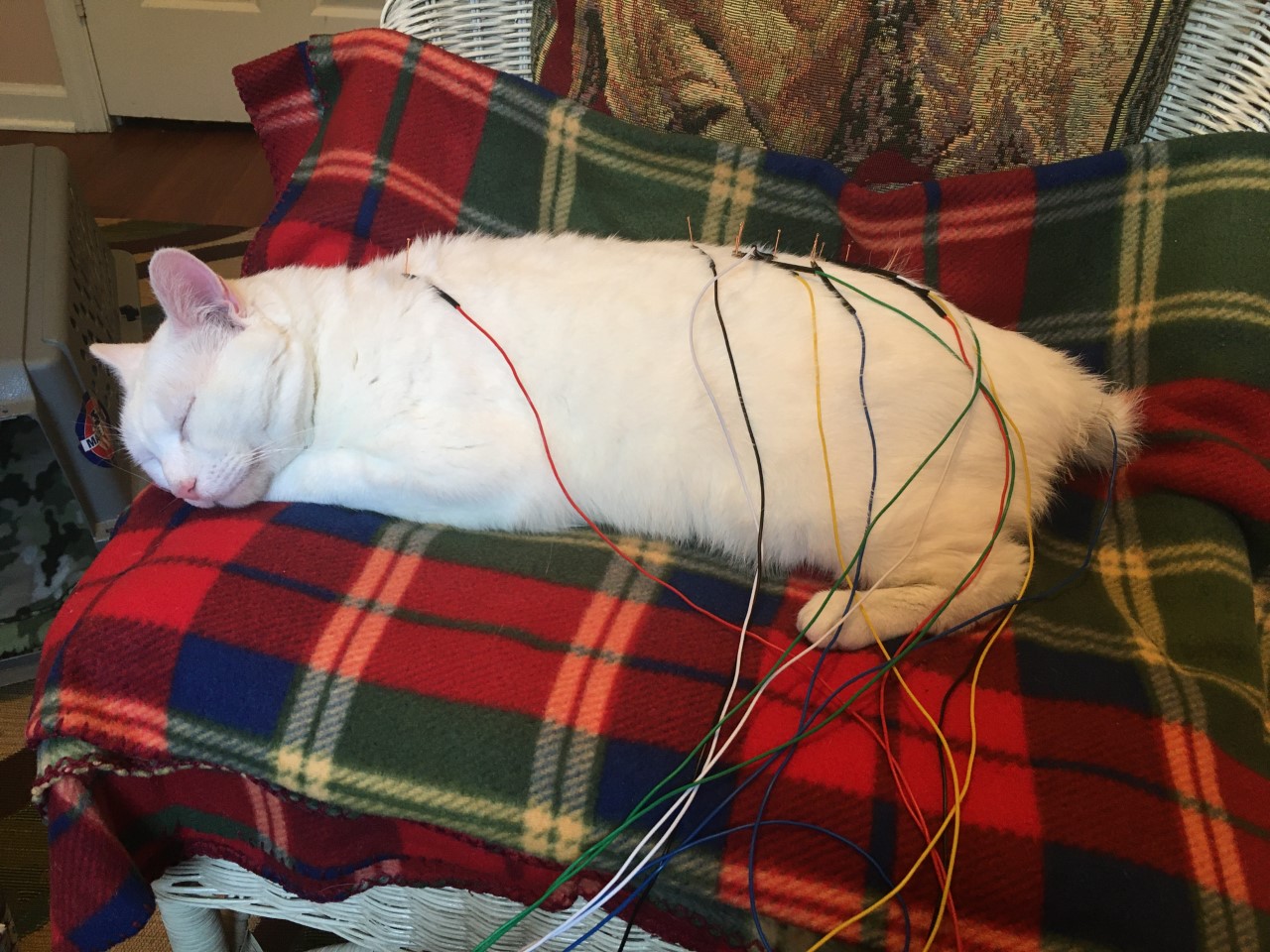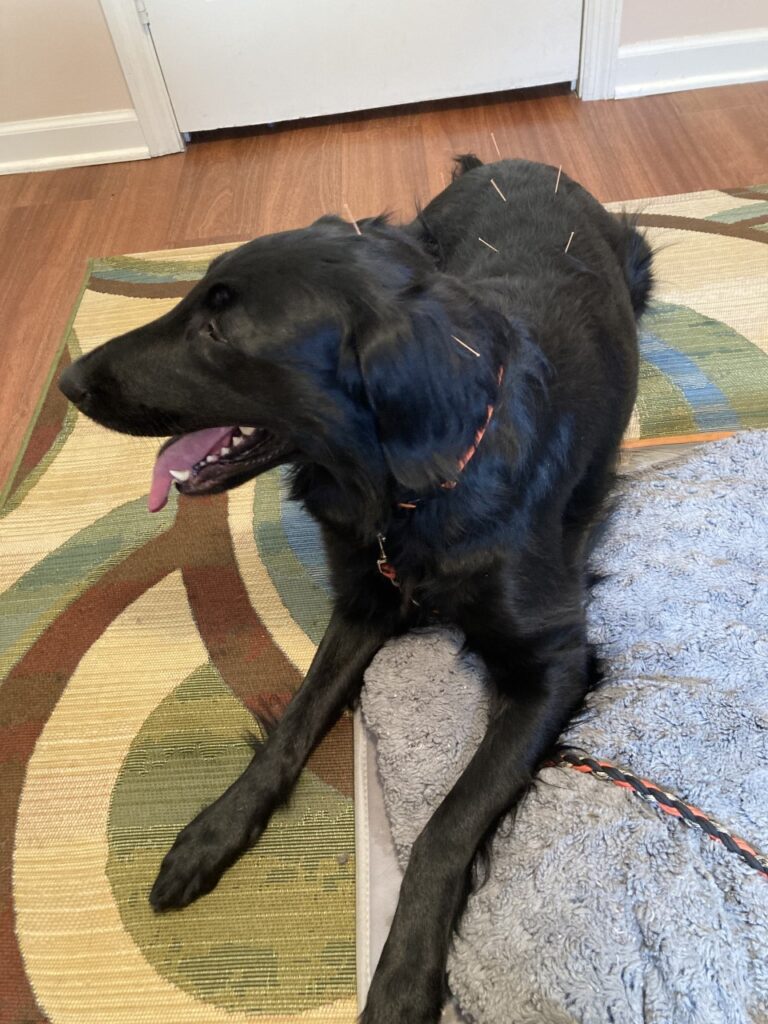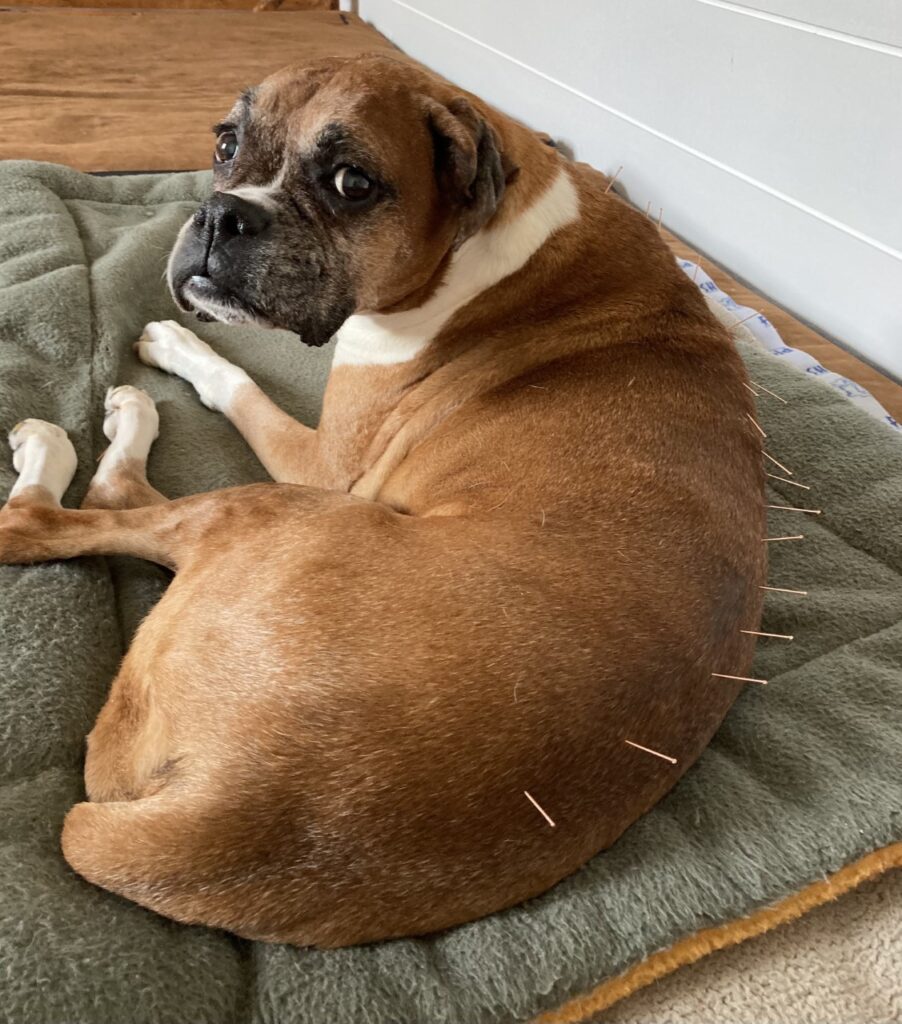Pet Acupuncture near Manchester, VT
Acupuncture
For thousands of years, acupuncture has been used to rebalance the total energy system of animals’ bodies, Qi, by placing tiny needles into the body at specific locations along meridians or channels to relieve pain, restore normal body functions, and facilitate health and healing. It effectively treats many conditions, such as arthritis, disc disease, musculoskeletal pain, nerve pain and paralysis, kidney failure, liver failure, cancer, heart disease, diarrhea, vomiting, and seizures.
Acupuncture can stimulate a pet’s appetite, or calm a patient who has anxiety issues. It can treat many conditions because Qi travels along meridians (pathways) throughout the body where it affects organs, muscles, joints, and all systems of the body, including the nervous and immune systems. In short, acupuncture relieves pain, reduces inflammation, and restores homeostasis within the body.

Frequently Asked Questions
Acupuncture usually involves the insertion of thin, sterile needles into discrete and specific points on the body called “Shu-xue” or acupoints to cause a therapeutic effect. But it may include other methods, such as laser acupuncture or moxibustion. Acupuncture techniques are used to get the energy in the body, Qi, to flow smoothly.
Yes. Acupuncture is a very safe medical procedure when administered by a qualified practitioner. Very few negative effects have been found in clinical cases. Acupuncture should be used with caution in cases involving pregnancy, open wounds, tumors, and fractures.
Rarely. Acupuncture is not painful because acupuncture points are stimulated using very fine needles, almost as thin as a strand of hair. Over 95% of patients are comfortable with acupuncture therapy. Due to the relaxation effect, some animals will fall asleep during acupuncture treatments. In general, sedation is not needed before an acupuncture treatment.
Each treatment session can take about 20 to 45 minutes.
Some results can be seen immediately, but others will require several treatments. For chronic conditions, a minimum of three to five treatments that are one to two weeks apart is needed before one can expect notable improvement. Remember, many conditions did not happen overnight and many usually have multiple symptoms before the condition was even noticed.
As in all medicine, this depends on the situation. Treatments can be done daily, weekly, monthly, or even further apart, depending on the severity and chronicity of the condition. Prevention is key, so starting acupuncture treatments once every two to six months when the animal is young is a wonderful way to help maintain a good-quality life force with no Qi blockages.
Studies have shown that acupuncture stimulation induces the following physiological effects:
- Pain relief
- Promotion of tissue healing processes
- Anti-inflammatory effects
- Immunoregulation
- Anti-febrile effects
- Regulation of gastrointestinal motility
- Hormone and reproductive regulation
Clinical trials indicate that acupuncture therapy can be effective in the following conditions:
- Neurological disorders: Seizures, intervertebral disc disease (IVDD), laryngeal hemiplegia, facial and radial nerve paralysis
- Gastrointestinal disorders: Diarrhea, gastric ulcers, colic, vomiting, constipation, impactions
- Musculoskeletal problems: Muscle soreness, back pain, osteoarthritis, degenerative joint disease
- Chronic conditions: Skin problems, heaves, asthma, cough, uveitis, renal failure, chronic liver diseases, behavioral problems, infertility, Cushing’s disease, hypothyroidism, hyperthyroidism, geriatric weakness, anhidrosis
- Other: Quality of life, cancer, hospice care, performance enhancement, and disease prevention
Acupuncture has been practiced in both animals and humans for thousands of years in China. The earliest veterinary acupuncture book, “Bo Le Zhen Jing,” is believed to have been written by Dr. Bo Le in the Qin-mu-gong period (659 BCE to 621 BCE). Veterinary treatment protocols using acupuncture are well-documented in this book. Since that time, acupuncture has been a part of the veterinary medical system in China.
Qi (pronounced “chee”) is the life force or vital energy. There are two contrasting forms of Qi: Yin and Yang. Yin energy tends to be cool, dark, still, and moving downward, while Yang energy is warm, light, mobile, expanding, and moving upward. Physiologically, Qi flows throughout the body all the time, maintaining the balance of Yin and Yang.
When the flow of Qi is interrupted by any pathological factor (such as a viral or bacterial infection), the balance of Yin and Yang will be disrupted and, consequently, a disease may occur. Pain is seen as a blockage of Qi flow. Acupuncture stimulation resolves this blockage, freeing the flow of Qi and enabling the body to heal itself. Homeostasis is restored when Yin and Yang Qi are in balance.
A channel or meridian is where Qi flows inside the body. The most commonly used acupuncture points are located along the 12 Regular Channels and 8 Extraordinary Channels mapped out in the body.
Modern research shows that acupoints are located in areas where there is a high density of free nerve endings, mast cells, small arterioles, and lymphatic vessels. Most acupoints are motor points.
A great number of studies indicate that the stimulation of acupoints induces the release of beta-endorphins, serotonin, and other neurotransmitters. The U.S. National Institute of Health’s National Library of Medicine (pubmed.gov) has more than 25,000 research papers regarding acupuncture, with more than 400 being animal-specific.
Only licensed veterinarians are qualified to practice veterinary acupuncture.
Many acupuncturists choose to combine acupuncture with herbal medicine because the use of herbs enhances the effectiveness of acupuncture. Most Chinese herbal medicines are made up of four to 15 individual herbs. Formulas are designed to correct the imbalances predisposing or causing disease and treat the condition, not just a single symptom.
In cases where a patient can be understood from a TCM perspective, Chinese herbal medicine can be integrated seamlessly with acupuncture to perpetuate the energetic stimulus provided through the acupuncture treatment.
Traditional Chinese Medicine (TCM) focuses on the natural energy balance of the body, Qi (pronounced “chee”), and its smooth flow within the body. All of the functions of the body can be described in terms of its Qi as it is translated as natural energy, life force, and energy flow. Each aspect of the body can have too much or too little. When the energy flow gets stuck or the amount is insufficient, symptoms are observed. Diseases are seen as an imbalance significant enough to overwhelm the body and result in physical and emotional symptoms that are created when the body is trying to re-establish a normal flow of Qi.
The goal of Traditional Chinese Medicine treatments is to help the body reestablish the normal amount and flow of Qi to optimize body functions. Traditional Chinese Medical treatments consist of nutrition, exercise, acupuncture, and herbs and can be beneficial in the treatment of many ailments. Once energy is strengthened and balance is restored to the body via TCM, the body’s natural healing processes can take over. TCM has been used for more than 2,000 years to balance Qi in the body.
TCVM has four main components:
- Acupuncture
- Herbal medicine
- Food therapy
- Tui-na (medical manipulation)
The diet of an animal is very important and can have positive or negative effects. Dietary changes have had positive effects on many behavioral and skin conditions. TCVM has long recognized the importance of food therapy in the treatment and prevention of illnesses. Recommendations to implement a special food or eliminate a certain food that an animal is currently being fed are not uncommon.
Tui-na is a form of Chinese manipulative therapy. It is often used in conjunction with acupuncture and Chinese herbs. From a conventional medicine perspective, Tui-na can be thought of as corresponding to a combination of acupressure, conventional massage, and chiropractic techniques. It can be used to treat both acute and chronic musculoskeletal conditions as well as many non-musculoskeletal conditions.
Get in Touch
Animal Wellness Veterinary Services uses safe and effective holistic treatments that will help your beloved pet recover from their ailments. Reach out to me to learn more about what I do.




